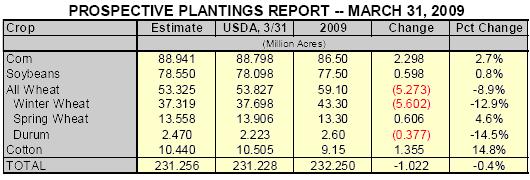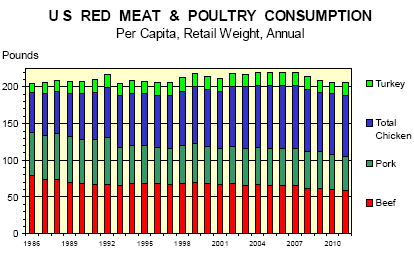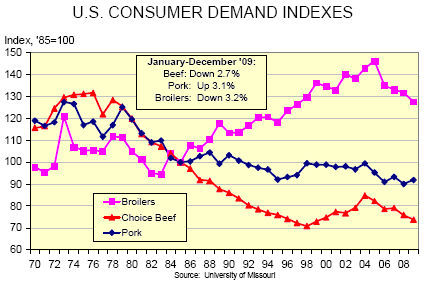



CME: US Meat, Poultry Sectors Face Harsh Reality
US - USDA’S Prospective Plantings Report, released on 30 March, indicates higher corn and soybean acres than one year ago, write Steve Meyer and Len Steiner. The harsh reality for producers is that the consumption of animal products is going to continue to decline.Both USDA estimates, though, were lower than the average of analysts’ pre-report estimates as published by DowJones and included in yesterday’s DLR. Estimated wheat acres were just over 500,000 higher than analysts expected with the majority of the added acres being winter wheat. Total acreage planted to these four major crops is virtually unchanged.

A harsh reality for the US meat and poultry sectors is that total per capita consumption of meat and poultry has decline significantly since its peak in 2006 and is quite likely to decline even more. For many years, we speculated on just how much meat US consumer can actually consume. The growth pattern was not always steady but it was long-standing and, after every reduction such as that of 1993 or 2000, new growth eventually pushed consumption to new record levels. Since the 2006 peak of 220.18 pounds per person, however, the total has fallen by 5 per cent (to 209.17) and is forecast by the Livestock Marketing Information Center to decline by another 1 per cent in 2010 and 2011.

There are a number of reasons for the decline so far and for the prospect of further declines:
- Lower production and growing exports. Both of those leave less product available for domestic consumption and dividing by a population that is still growing by 0.8 to 0.9 per cent per year drives per cap figures down. It remains true that year-to-year changes in per cap consumption are more a measure of output changes than they are a measure of consumer preferences. But the long-term per cap consumption trends is quite important for individual species and the sector as a whole.
- Changing demographics. 85 million Baby Boomers are reaching ages which historically have been associated with lower activity levels and consumption. An aging America will not be positive for meat consumption.
- Cultural trends that are working against meat intake. Everything from animal rights to HSUS to “meatless Mondays” to a growing number of young people who eat little or no meat suggest that this trend is far from over.
Of course, consumption is not demand. Demand includes consideration of the prices that various levels of consumption will command. But including prices to arrive at demand indexes does little to improve the picture. Indexes for the three largest species peaked with the Adkins Diet in 2004-2005 and have trended downward since. Only pork managed meager gains in 2007 and 2010.












